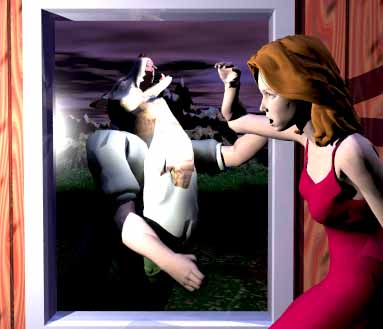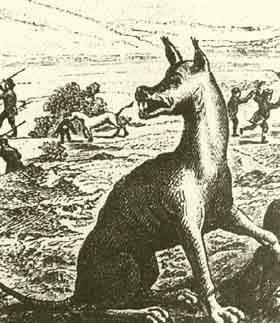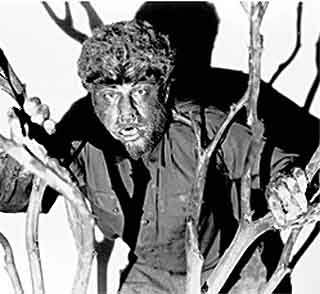
A
werewolf at the window can be frightening... (Copyright
Lee Krystek, 2003).
|
Werewolf!
On a July night in 1958 Mrs. Delburt Gregg was getting
ready for bed in her Greggton, Texas, home when she glanced out
the window. Thunderstorms were on the way. When a sudden flash
of lightning illuminated the countryside she saw a horrific sight
outside her open window. It was a "huge, shaggy, wolf-like
creature" that was clawing at the screen and glaring at her
with "baleful, glowing, slitted eyes."
This account comes not from a horror movie, but
from an interview with the Gregg in a 1960 issue of Fate
magazine. What did she see? The description sounds like a werewolf,
but they don't exist, do they?
The root of the word werewolf goes back to the old
word wer which means man. A werewolf is therefore a man-wolf:
part human, part beast. Though most people today associate werewolves
with Hollywood movies and especially with actor Lon Chaney, Jr,
the idea that a creature exists that can change from man to a
wolf and back has been well-embedded in legend and folklore for
more than two-thousand years.
An ancient Greek myth tells the story of Lykaon.
Lykaon is a man that serves the King of the gods, Zesus, human
flesh. Zesus is so angered at Lykaon that he turns him into a
wolf. Later, a Greek cult would be build on this myth. Adherents
believed that one could turn oneself into a wolf through human
sacrifice.
Why were werewolves so feared? In Europe the wolf
was the predator that most concerned man. Stories of attacks on
people are common in medieval literature. Although many scientists
believe modern wolves are little threat to man and simply have
a bad reputation, others suggest their ancestors, not scared of
man's firearms, may have been much more aggressive. Certainly
the Beast of the Gevaudan was one such animal.
The
Beast of Gevaudan
In the summer of 1764 a woman tending cattle in
a mountainous region of France called Gevaudan had a frightening
encounter. She saw a horrible beast the size of a cow or donkey
approaching her. The beast looked like a gigantic wolf. Fortunately
for the girl, the cattle used their horns to drive the animal
away.
Just one month later, however, the animal struck
again. This time the victim was a little girl who did not escape,
but reportedly had her heart torn from her body. Other human killings
followed. In October two hunters managed to shoot the creature
from a distance of only about 30 feet. The wounded creature slunk
off into the woods, but did not die. Within a few days it was
back to its murderous ways.
The ability of the creature to survive such an attack
seemed supernatural. Soon the people in the countryside were certain
that the animal on the loose was not just a wolf, but a werewolf,
or loup-garou.
|

The
Beast of Gevaudan appears in a period woodcut.
|
After a vicious attack on two more children, King
Louis XV sent a troop of his cavalry to rid the region of the
monster. The commander, Captain Duhamel, sent his troops over
the countryside looking for the beast. Though they spotted the
creature on a number of occasions and shot at it, they never could
find the body. The beast disappeared for a while and the calvary
withdrew, thinking the creature must have died of wounds inflicted
by the shots. The soldiers were not gone long, however, before
the monster returned and the killing started again.
Eventually a large bounty was put on the beast attracting
hundreds of professional hunters into the area. Though over a
hundred wolves were killed, none proved to be the monster. It
continued to roam freely and kill throughout the summer of 1765.
In June, 1767, the Marquis d'Apcher organized several
hundred hunters into small bands and set off into the countryside
to try and find the beast. The Marquis' plan worked and a small
group found the monster. One of its members, Jean Chastel, spotted
the beast and fired his gun twice at it. The second shot apparently
hit the animal in the heart and it fell dead.
The creature was later examined. Within its stomach
was found the collar bone of a young girl. By some estimates the
monster had been responsible for the death of sixty people. The
body, after being displayed in the streets and later sent to Versailles,
was buried in the countryside.
A modern analysis of the examination report supports
the idea that the creature was simply a very big wolf. However,
the story of the Beast of Gevaudan, along with other similar incidents,
undoubtedly helped fuel the folktales about werewolves. This was
idea not mitigated by the fact that Chastel, the hunter who had
finally killed the beast, had used silver bullets.
In
the Mind
Incidents like the Beast of Gevaudan seemed to give
the occasional wolf almost supernatural powers and people began
to connect the idea of a werewolf to satanic powers. This was
strengthened by theological writers, like St. Augustine, who wrote
about witches having the power to change men into wolves.
The truth is that change probably only occured in
the subject's mind. People who testified that they had turned
themselves into wolves often used a salve that they rubbed on
their bodies to make the transformation. This salve, rather than
having the capability to change the physical shape of the person,
was a hallucinogenic (often containing the plants belladonna or
nightshade) This tricked the subject's mind into thinking he'd
been changed while he actually lay in a coma or ran on a drug-induced
killing spree. In 1598, when authorities found Jacques Roulet
crouched over the body of a mutilated and dead teenager, he testified
that he'd rubbed his body with an ointment which changed him and
he'd done the crime as a werewolf.
Some werewolf hallucinations may have been accidentally
inflicted. The diet of medieval peasants often included bread
infected with the Ergot fungus. Chemicals in the fungus are similar
to LysergicAcid Diethylamide (LSD) which is a powerful hallucinogenic
and psychoactive drug. People who ingest food contaminated with
Ergot report having horrible visions that include being attacked
by, or turning into, vicious animals.
Mental illness may also account for some people
who reported changing into werewolves. One famous case from 1589
involved a man named Stubbe Peeter. Peeter was convicted of a
series of murders and cannibalism. He claimed he'd made a pact
with Satan and was given a girdle that turned him into a wolf.
Peeter was probably what we would consider a mentally-ill serial
killer today, but in the days before modern psychology his story
of transformation and satanic power might have been very believable.
The psychological condition of believing you are a werewolf is
known as lycanthropy.
It is possible that other medical conditions also
aided the werewolf legend. Individuals that suffer from the genetic
disorder known as hypertrichosis or other similar diseases
may grow hair all over their bodies, especially on the upper torso
and face. Someone not knowing about this condition might easily
mistake such an affected individual for a werewolf.
Fear of werewolves was very real in the middle ages.
Records show that in France alone between the years of 1520 and
1630 over 30,000 people were suspected of being werewolves. Like
in the more familiar witch trials, many people found themselves
accused of being werewolves, then investigated and even tortured
into confession.
Modern
Werewolves
So are werewolves gone - vanquished from everywhere
(but the movie screen) by a modern understanding of drugs and
mental illness? Not quite.

Actor
Lon Chaney, Jr in his role as the Wolfman from a publicity
still for the 1941 motion picture.
|
In the fall of 1989 a woman traveling along Bray
Road near Dalavan, Wisconsin, reported seeing a figure hunched
by the side of the road. As she passed it, she looked out and
saw a face that was "...long and snoutly, like a wolf."
The figure also had grayish-brown hair and big fangs. The driver
continued on and reported the encounter to a local paper.
A few years later in 1991, on the night of October
31, a driver navigating down Bray Road hit something she hadn't
seen. When she stopped the car to look back she saw a dark, hairy
form running toward her. She raced off in her car, but the creature
leapt onto the back trunk. Fortunately the car was slippery and
it fell off.
Are these modern werewolves? Or just pranksters?
Or maybe just very large and weird dogs? No satisfactory explanations
for the sightings have yet been found.

Copyright
Lee Krystek 2003. All Rights Reserved.